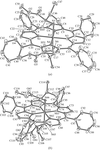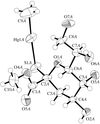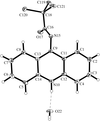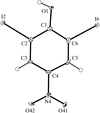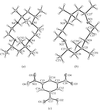issue contents
August 2002 issue

Cover illustration: The hydrogen-bonded layer perpendicular to the Fe-Odioxane vector in the polymer chains of catena-poly[[diaquadichloroiron(II)]-![[mu]](/logos/entities/mu_rmgif.gif) -1,4-dioxane-
-1,4-dioxane-![[kappa]](/logos/entities/kappa_rmgif.gif) 2O:O']. See Speer Jr & Pinkerton [Acta Cryst. (2002), C58, m441-m442].
2O:O']. See Speer Jr & Pinkerton [Acta Cryst. (2002), C58, m441-m442].
inorganic compounds
Download citation


Download citation


Rb(GaPO4)2(OH)(H2O)·H2O exhibits a three-dimensional framework with intersecting eight-ring channels, in which the alkali cations and the water molecule are encapsulated. This network belongs to the leucophosphite structural type.
Download citation


Download citation


The title compounds are isotypic. KMo5O13 has a three-dimensional tunnel built by the corner-sharing of MoO6 octahedra; K+ cations are located in the tunnels. In KNb1.76Sb3.24O13, the Nb and Sb atoms occupy the same sites.
Download citation


Download citation


Fe7(PO4)2(HPO4)4 is isostructural with Mn7(PO4)2(HPO4)4 and Co7(PO4)2(HPO4)4. The structure is based on a framework of edge- and corner-sharing FeO6, Fe5 and PO4 polyhedra, isotypic with that found in the mixed-valence iron phosphate Fe7(PO4)6. The Fe atoms are purely in the divalent state, just like the Co atoms in Co7(PO4)2(HPO4)4, the necessary charge balance being maintained by the addition of H atoms in the form of bridging Fe—OH—P groups.
metal-organic compounds
Download citation


Download citation


Download citation


Download citation


Download citation


Download citation


Download citation


Download citation


Download citation


Download citation


Download citation


Download citation


Download citation


Download citation


Download citation


Download citation


Download citation


Download citation


Download citation


Download citation


Download citation


Download citation


Download citation


Download citation


Download citation


Download citation


organic compounds
Download citation


Download citation


Download citation


Download citation


Download citation


Download citation


Download citation


Download citation


Download citation


Download citation


Download citation


Download citation


Download citation


Download citation


Download citation


Download citation


Download citation


Download citation


Download citation


Download citation


Download citation


Download citation


Download citation


Download citation


Download citation


Download citation


Download citation


Download citation


Download citation


Download citation


Download citation


Download citation


Download citation


Download citation


Download citation


Download citation


Download citation


Download citation


Download citation


Download citation


Download citation


Download citation


Download citation


Download citation


Download citation


Download citation


Download citation


Download citation


Download citation


Download citation


Download citation


Download citation


Download citation


Download citation




 journal menu
journal menu




















